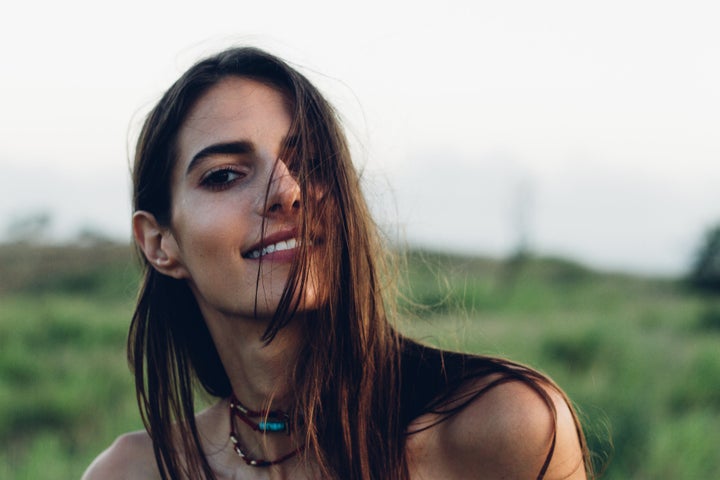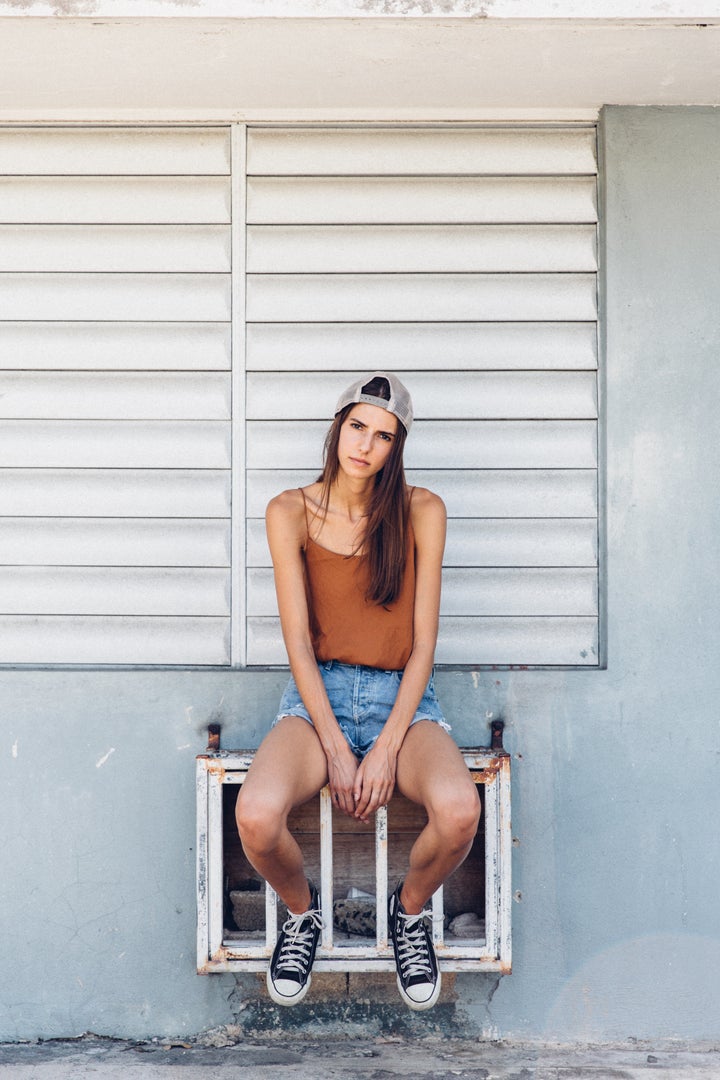“#NoMoreAnorexicModels,” I read. The comments from Free People’s 3.3 million followers beneath the photo of me modeling their clothes stacked with such speed my iPhone struggled to keep up. My stomach sank. Phrases like, “Eat something” followed “Food is delicious.” Bare skin showing from my grey strapless dress in Puerto Rico was enough for strangers to jump to conclusions about my body.
I shrunk into my chair, wishing I hadn’t told my friends to keep an eye out for my photo shoot. I knew this happened to Kendall Jenner and Selena Gomez on a daily basis — being picked apart over the slightest imperfection — but this was just me. I was hiding a secret, but not the one they thought.
I am a cancer survivor. I was diagnosed with Hodgkin’s Lymphoma when I was 19 years old. One day my college roommate was coaching me on how to be flirty and cool when texting a boy and the next day a nurse was teaching me how to inject myself with white blood cells.
I got chemo through a port, a device surgically placed in my chest that flowed medicine to my heart. As I sat in the hospital, my shiny bald head matching my dad’s, I read fashion magazines. Enduring an ugly illness, I wanted to witness beauty. Hilary Rhoda, an athletic model who hailed from my all-girls high school, inspired me. She left our town for glossy magazine covers.
Now, after four years in remission, I was questioning why I’d chosen such a public profession.
“Dad, are you seeing this?” I asked, showing him my picture ripped apart by trolls.
My dad read the comment, “Someone give this girl a doughnut” out loud and burst into laughter. “That’s a good one,” he said. His short sentences accentuated his Eastern European matter-of-fact sensibilities.
“How is this funny?” I asked.
“Alexandra, this isn’t real. This doughnut guy doesn’t know what you’ve been through.”
I smiled. His words echoed in my head later as I picked up an order from Krispy Kreme. I bit down on the chocolate glaze recalling when eating wasn’t as casual.
Four years earlier, I stared at a plate of pesto pasta my Puerto Rican mom had made for me in Silver Spring, Maryland, where I grew up. I was famished, malnourished, terrified at my own sight in the mirror, but I couldn’t eat. I chewed a single curl of fusilli despite the burning it caused. I tried to hide my frustration, but my tears gave me away. I’d developed ulcers in my mouth from the toxicity of my medications that traveled down my esophagus and into my intestines. I don’t know how many pounds I lost, but at my height of 5 foot 10 inches, it was unsettling.
When the tumor shrank and my cancer died, it was as if I was assigned a new body. I was comfortable with the scars that remained after surgery, chemo and radiation. It was oddly satisfying that my figure matched what I endured.
When treatment ended, so did the prescription pills. Without a numbing agent, the trauma of terrifying moments washed over me on an endless loop. The day I woke up with a tube sticking out of my chest, losing feeling in half of my body, or when my dad had to carry me into my last days of treatment — all these moments and more flooded me.
With years of dedication and patience, therapy relieved my panic attacks, self-help books trained me to take back control of my emotions, and meditation soothed me into the present moment.
Throughout my rehabilitation, a kernel of hope lodged in the back of my mind. If I could get healthy enough to model, I might inspire another young cancer kid like me not to give up.
Counterintuitively, I needed to put on weight to participate. I gained 15 pounds in one year with the help of nutritionists, switching cardio workouts for weight training, as well as with the help of almond butter smoothies.

Motivated by my hope to encourage those in remission to see beyond their pain, I left my safety nets at home and moved to New York. I pursued my vision while still healing. After a series of missteps and perseverance, I signed an exclusive two-year contract with a top agency, keeping my survivorship hush. I was afraid the industry wouldn’t be as accepting of my perceived flaws as I was. I checked the box marked “no” when asked if I had scars or tattoos, carefully covering the delicate cancer ribbon ink on my pinkie finger.
In hindsight, I lied about my past because I no longer wanted to define myself by my disease. I had a chance at a fresh start and looked up to the experienced models who I assumed had clean records of health.
The fashion industry opened its world of fantasy to me. I felt at home backstage observing designers, like Maxwell Osborne and Dao-Yi Chow, approve finishing touches to their influential designs. While I sat in the hair and makeup chair, I peaked through brushes and aerosol spray to devour the last chapter of “The Power of Now.”
Ironically, walking the runway dissolved my anxiety — I transformed from young cancer survivor burdened with knowing too much about life and death into a supermodel, or so I felt. For 60 seconds, I was fierce. Nothing existed but the clang of my heels on the runway, each step synchronized to the unrecognizable rock music playing overhead. I marched toward the blinding light, past the iconic platinum bob of Anna Wintour. I felt cool as each click of the photographers’ shutter became louder. Each show under my belt injected more assuredness into the other parts of my life.
New York fashion week was only twice a year, so I began to rely on photo shoots to become more familiar with my new body. I harnessed my emotions; all that I was privately dealing with exuded from me and I left each shoot lighter in spirit. I discovered freedom in front of the lens. Where I was once shy and awkward, I found myself dancing, smiling, pouting and feeling sexy, even.

My model life was far from typical. I traded clubs for movie nights, drinking for sobriety and model houses for living with family in the city. My days were centered on restoring peace within myself. When I dealt with inevitable self-doubt from repeated rejections at castings, designers telling me my hips were too wide and my boobs were too small, I tried to stay focused on my purpose ― to build a platform where I might energize girls and boys like me, who thought their life would never feel enjoyable again, to dream big.
Modeling was an opportunity to be present. When designers, photographers, lighting assistants, and creative directors were staring at me to bring designs to life, I couldn’t fret over my past fears, or even my current self-doubt. I had to step forward with confidence, in front of an audience no less.
The Free People shoot in Puerto Rico was no different. The long brunette hair I had earned back blew in the wind — each inch representing a milestone I’d overcome. My port scar was visible in my off-the-shoulder sundress, and for the first time I hadn’t tried to cover it. I no longer emulated girls in magazines, I was just me. I hadn’t reached my pre-illness weight, yet I was at peace with my frame. I didn’t feel I fit in in the industry, but knowing who I was as a survivor grounded me. Most of all, I was finally having fun again.
Gratitude washed over me. Free People, a brand that stands for female empowerment and freedom, stood by me. They never took the picture down and continued to photograph me. The negative commenters couldn’t take away my belief in myself, because they hadn’t given it to me. I was no longer ashamed of my secret. My survivorship was the very source of my strength.
Alex Dvorak is working on her memoir. You can follow her on Instagram at @itsalexdvorak.
Do you have a compelling personal story you’d like to see published on HuffPost? Find out what we’re looking for here and send us a pitch!
Credit: Source link